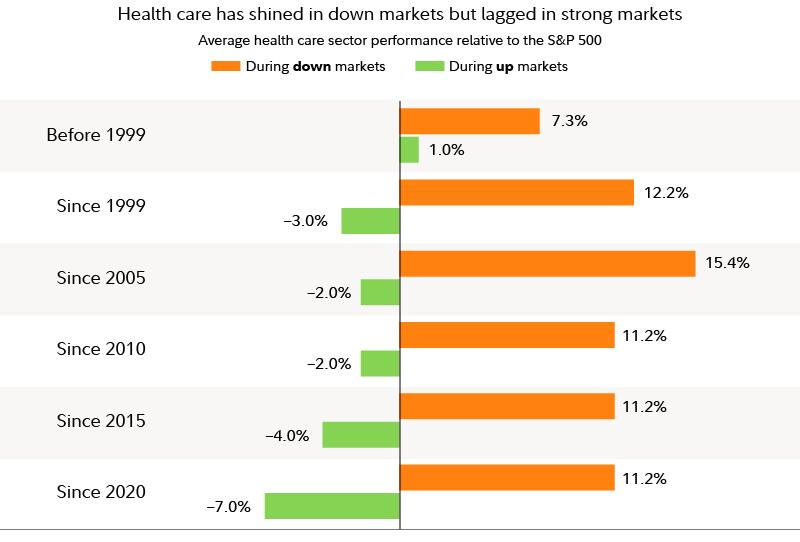by Denise Chisholm, Director of Quantitative Market Strategy, Fidelity Investments
Denise Chisholm still sees open runway for US stocks—including tech.
Key takeaways
- While many investors are worried that the bull market in general, and tech stocks in particular, have gotten ahead of themselves, my research suggests the opposite.
- Stocks' gains have tracked fundamentals, suggesting the rally that started in 2022 may continue.
- Tech stock valuations are backed up by enormous free cash flow and strong earnings power.
- Some cheap segments of the market might be cheap for good reasons.
Even after the recent market pullback, US stocks have overall been having a strong year so far.
While US stocks saw some hints of a market broadening in July, this has still been tech's year. Mega-cap tech companies have been driving the market's overall gains, as investors try to get their arms around the size of the potential opportunity presented by the rise of artificial intelligence.
My research focuses on analyzing market history to uncover patterns and probabilities that can help inform the current outlook. Recently, my research has suggested that the stock market broadly could still have room to run—fueled by strong underlying fundamentals—and that even the tech sector does not appear to be out over its skis yet. My research has also turned up some bearish signals on some relatively cheap market segments: health care and international stocks.
Here's more on 3 key themes for investors to consider now.
1. Stocks don't appear to be out over their skis
US stocks have come a long way since this bull market began in October of 2022, with the S&P 500® up around 50% through mid-August.
Those strong gains have some investors worried the market has come too far too fast, and fearful that the recent pullback may be only the beginning of a deeper decline. But my analysis suggests the opposite.
I compared stock returns with a key index of leading indicators. Leading indicators are metrics that tend to turn before the broader economy turns, so they can give clues about what's coming down the pipeline for the economy (in contrast with lagging indicators, like unemployment, which tell you about what's already happened in the economy). The Organization for Economic Co-operation and Development (OECD) compiles the US Composite leading indicator index (CLI), which measures a basket of leading indicators in an attempt to provide early signals of turning points in the business cycle.
What I found in the data is that stock returns and the CLI have accelerated at about the same rate since December 2022, which historically has been typical for this stage of a bull market cycle. However, the CLI's rise has been relatively modest—bringing the index only to the second quartile of its absolute range—implying that there could be further room for improvement and room for more good news to be priced in.
Historically, stocks have returned 13% over the next 12 months, on average, after comparable CLI readings since 1962.
Stock gains also appear to have been well supported so far by earnings growth, with stock returns closely tracking changes in analysts' earnings-growth estimates. Similarly, this has been a common pattern in historical bull markets, and it has been a positive signal for the market in the past.
When leading indicators and earnings growth have accelerated together like they have recently, the market has returned about 10% over the next 12 months, on average.
Read the full report
Get Fidelity's complete Q3 2024 Investment Research Update, from the desk of Denise Chisholm, director of quantitative market strategy. Download the full report (PDF).
2. Tech has earned its big gains—and looks to still have runway
Sometimes, rather than presaging a pullback, gains lead to more gains.
That's what my research suggests could be at hand for the tech sector—similar to what I'm seeing for US stocks broadly.
Technology companies have been producing voluminous free cash flow, helping to justify their high price-earnings ratios (P/Es). In fact, the sector's relative price-to-free-cash-flow ratio (meaning, the sector's ratio compared with the market's ratio) has actually fallen this year, to below its median level and to the second quartile of its range since 1992. Historically, this has been a bullish signal for the sector's subsequent 12-month relative returns.
What's more, the sector's earnings power could help support continued advances. Tech earnings growth has accelerated from contraction territory to the top 10% of its historical range in the span of one year.
In the past, this has been a positive sign for both the broad market's absolute performance and tech stocks' relative performance, with the S&P advancing an average of 17% over the next 12 months historically and tech stocks outperforming the market, in similar past periods.
Third quarter 2024 Investment Research Update
3. Be cautious with some cheap market segments
There's no denying that this has been a narrow bull market. Stocks' rally has been top-heavy and tech-heavy, with a small number of large growth stocks powering the market's gains.
After such a lopsided rally, some other parts of the market now look cheap by comparison. While some of those areas may represent opportunity, my analysis suggests 2 segments to approach with caution: health care and developed-market international stocks.
Take health care. The sector historically has traded at a premium to the overall market, with a forward P/E ratio about 18% higher than the market's, on average since 1976. That premium has shrunk to only about 5% recently. But the sector has gotten cheaper for what I believe is good reason: Its profit margins have declined steadily since the 1960s. And while health care used to routinely outperform during both up and down markets, since 1999 it has tended to trail when the market gains ground.
 Past performance is no guarantee of future results. Down markets defined as years when the S&P 500 was down 10% or more year over year. Up markets defined as years when the S&P 500 was up 10% or more year over year. Analysis based on the S&P 500. Sources: Haver Analytics and Fidelity Investments, as of April 30, 2024. Data analyzed monthly since January 1963.
Past performance is no guarantee of future results. Down markets defined as years when the S&P 500 was down 10% or more year over year. Up markets defined as years when the S&P 500 was up 10% or more year over year. Analysis based on the S&P 500. Sources: Haver Analytics and Fidelity Investments, as of April 30, 2024. Data analyzed monthly since January 1963.
Similarly, my research raises concerns that developed-market international stocks could be a value trap. US stocks have outperformed developed international stocks by wide margins in recent years. As a result, international stocks' valuations relative to the US recently fell near their lowest levels in more than 3 decades (based on the median P/E in the MSCI EAFE Index of developed international markets and the median P/E in the S&P 500).
Counterintuitively, such extreme cheapness has not been a bullish signal for international stocks in the past. Following past periods when the EAFE's relative P/E was in the bottom quartile of its historical range, international equities lagged the S&P 500 some 73% of the time over the next 12 months.
To understand that lagging performance, you have to bring it back to fundamentals: US companies have simply been out-earning international companies, on average. Even after adjusting for differences in sector weights (so removing the heavy influence of the US tech sector), earnings growth among US companies has outpaced earnings growth among MSCI EAFE companies by about 2 percentage points per year on average, since 1990.
In conclusion
To be sure, sometimes strong performance can become overdone, and oftentimes cheapness is a buying signal. But my analysis suggests the opposite for the segments mentioned above.
Based on my research, the economic and market environment appears likely to support continued gains for the stock market broadly and the tech sector in particular. And I suggest investors approach health care stocks and developed international stocks with caution.
Copyright © Fidelity Investments















